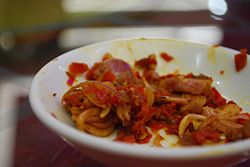Cincalok
 A bowl of cincalok | |
| Alternative names | Chinchalok,cencaluk,cencalok |
|---|---|
| Type | Condiment |
| Course | Appetizerormain course |
| Place of origin | Malacca[1][2] |
| Region or state | Southeast Asia |
| Associatedcuisine | Brunei,Indonesia,MalaysiaandSingapore |
| Serving temperature | hot or room temperature |
| Main ingredients | Smallshrimporkrill |
Cincalok,alsocencaluk,is aMalay condimentthat originated inMalacca,Malaysia,consumed byMalays,PeranakansandKristangs.Its origins can be traced back to the Portuguese occupation ofMalacca.Thiscondimentconsists offermentedsmallshrimporkrill,which are calledudang geragauin Melaka and are easily identifiable in the mixture. It is predominantly salty in taste, and is usually served together withchillis,shallotsandlimejuice. Sir R. O. Winstedt has written about "Cencaluk" inMalaysiain his book "The Circumstances of Malay Life - 1909".[3]This shrimp is seasonally available in Pantai Klebang, Limbongan, Tanjung Kling and several coastal areas.
Presently, cincalok making enterprises are gaining ground in several areas in the state of Melaka. The state government itself has designated theState Legislative AssemblyconstituencySungai Udangas the area to produce cincalok in the 'Satu DUN Satu Produk' plan.
Apart from that, cincalok is also now easily available at roadside stalls and in the markets around the state.
The consumption of cincalok has also spread toRiauandWest KalimantaninIndonesia.It is similar tobagoong alamang(seeshrimp paste) in the Philippines andkhoei chalu(Thai:เคยฉลู) in Thailand.
Cincalok manufacturing
[edit]The process of making cincalok requires several steps. Fresh small prawns (udang geragau) are combined with salt and rice in equal proportions. After the ingredients are thoroughly mixed, they are sealed in a jar and allowed to ferment for three days. There are also cincalok-makers who increase the proportion of rice in the mixture, believing it to enhance the taste of the finished product.
As the finished product is fermented in a sealed glass container, pressure builds up inside the container. Hence, care must be taken when opening a pressurized container of ready-made cincalok.[4]
See also
[edit]References
[edit]- ^Clark, Melissa (30 August 2006)."From Malaysia, a Pungent Ferment".The New York Times.
- ^"Cincalok | Traditional Dip from Malacca | TasteAtlas".
- ^The Circumstances of Malay Life, Sir Richard Olof Winstedt, Richard Winstedt, Ams PressInc, 1909 - Social Science - 90 pages
- ^Clark, Melissa (30 August 2006)."'From Malaysia, a Pungent Ferment' - The Chef: Zak Pelaccio, New York Times Dining & Wine ".The New York Times.
- Gateway to Peranakan Food CultureGek Suan Tan, Tan Gek Suan, Wing Fee. Asiapac Books Pte Ltd.ISBN981-229-389-2


